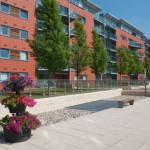Manchester is set to become a very popular location for domestic and international property investors in property and may push London off the top spot, a new report suggests. Manchester’s property prices are projected to rise by at least 22.2 per cent in the next three years, according to the report from property investment firm […]
Manchester is set to become a very popular location for domestic and international property investors in property and may push London off the top spot, a new report suggests.
 Manchester’s property prices are projected to rise by at least 22.2 per cent in the next three years, according to the report from property investment firm IP Global.
Manchester’s property prices are projected to rise by at least 22.2 per cent in the next three years, according to the report from property investment firm IP Global.
The government has pledged a £7 billion investment in Manchester over the next five years as part of its Northern Powerhouse plans, while 65 of the FTSE 100 companies now have an office in the city.
With the population expected to rise by 128,000 over the next decade, the demand for property is sharply on the rise. This demand is currently not being met by the city’s construction pipeline, pushing up property values even higher. In 2014 just 212 new residential units were delivered, a fraction of what is required.
The UK has always been seen a safe haven for foreign investors, but Manchester is now leading the charge outside London as investors look for higher-yield assets outside the capital. The investment community is also looking to capitalise on the growing labour market, strong transport links and significant government investment,” Jonathan Benarr, senior investment manager at IP Global, said.
Outside Manchester central London remains a prime location for investors. However, the IP Global report shows that interest has also turned to areas such as Ilford, Lewisham and Sutton with the imminent prospect of Crossrail and a number of regeneration programmes.
“Even with uncertainties around mansion tax and the outcome of the General Elections, we are not seeing investors deterred from the UK property market. As people realise there is just as much opportunity in Manchester as there is in London, we can expect this particular Northern Powerhouse to build on its position as a key investment destination,” Benarr added.
***
Manchester property statistics
Average property prices in Manchester
– Average price of a flat in Manchester is £160,030 according to Land Registry UK; one-bedroom apartments can start as low as £100,000 in the city centre; (this includes all types of sales e.g. older flats, re-sales etc)
– NB – by the close of 2014, the average property price was 19% below peak
– By comparison, the average price of a one-bedroom flat in London is approx.. £350,000
– ‘Buy-to-let’ – nearly 30% of homes in Manchester are in the private rented sector
– Current rate of house building – by the end of 2014, only 212 residential units were delivered to the market; by the start of 2016, an additional 1,426 properties are expected to be delivered
Buy-to-let and the private rented sector
– There is increasing institutional interest outside London for the private rented sector, because the capital is very expensive
– The private rented sector must be site specific – ie. In Manchester, an offer to the university community around the neighborhoods of the University of Manchester is a key area. Investors can benefit by letting out their residential properties to the “temporary” residents at the University
– The private rented sector also flourishes at ‘professional locations’ ie those in or near regional city centres; this applies to Manchester whose city centre has become a hub of commercial activity in recent years
– Examples of commercial hubs are Northern Quarter, China Town, Salford (impact of Media City UK) – more specifically, the fringes of Salford close to the city centre offer a pocket of value within Manchester and still easy access to the city centre. Any residential properties which offer easy access to these areas will be a hot investment, as it serves a professional population.
– This year HSBC highlighted Manchester as the 2nd highest yielding buy-to-let hotspot in the UK (last year it came 4th), thus showing how the market is gaining popularity and strength.
– The supply/demand imbalance also results in excellent potential for capital appreciation.
– More value in office rents, space, the cost of living and relative close proximity to both London and the rest of the UK help make Manchester so attractive as a commercial hotspot.
Housing market and construction
– The residential stock pipeline in Manchester is still playing catch up after the recession, it is unlikely to meet demand for several decades, especially as the population is expected to increase by 128,000 in the next 10 years
– Some notable new buildings include the Chips building within the New Islington regeneration project; Axis Tower and the waterfront residential buidlings at Salford Quays (was once an industrial area)
– The regeneration plans going on throughout Manchester, alongside the vast amount of backing from the UK government for its ongoing productivity and infrastructure improvements all create security within the market
– Yesterday’s UK Budget announcement underlined the government’s commitment to its Northern Powerhouse vision with Manchester handed the right to retain increases in business rates revenue. This move is expected to drive the delivery of city-specific infrastructure and regeneration plans, creating more opportunities for private and overseas investment.














